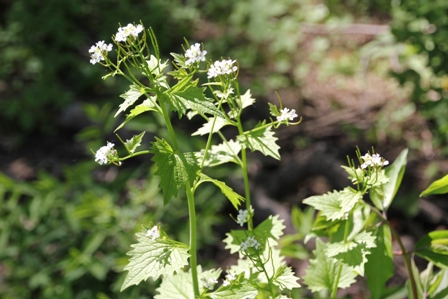 The name of this plant may conjure thoughts of a tasty meal. But for gardeners and native plant lovers, garlic mustard has a bitter flavor: it’s an invasive species brought over by the settlers in the 1800s, and it’s taking over yards and forest floors.
The name of this plant may conjure thoughts of a tasty meal. But for gardeners and native plant lovers, garlic mustard has a bitter flavor: it’s an invasive species brought over by the settlers in the 1800s, and it’s taking over yards and forest floors.
How did garlic mustard (Alliaria petiolata) move from spicing up a few colonial gardens to dominating the northeast? Here are just a few of this plant’s clever adaptations:
- Its roots leach chemicals that destroy the important fungal partners of nearby plants.
- It makes a type of chemical antifreeze that helps it stay green in cold weather, allowing it to shoot up as soon as the snow is gone.
- Each plant can release a thousand or more seeds.
- Even after you remove the plant from your yard, its seeds can hang out in the soil for five years (or more).
- It is toxic to some insects. Some types of butterfly eggs laid on its leaves will fail to hatch.
How to ID Garlic Mustard
Garlic mustard’s most iconic features are its green heart-shaped leaves with deep veins and tiny four-petaled white flowers. Note that the flowers don’t appear during the plant’s first year. You can also employ the smell test: true to its name, when crushed it gives off a garlicky smell.
Removing Garlic Mustard
May into early June is the best time to remove this plant from your yard. Many of the plants are flowering, making them easy to identify, but they haven’t yet had time to make seeds.
To remove a garlic mustard plant, grab it at the very base, and twist while pulling upwards. If the soil is loose, you may be able to pull up the roots, eliminating any chance that the plant could regrow. But even if you’re only able to pull up the above-ground portion, you will have at least stopped the seed-making process for this year.
Once you’ve picked the plants, put them in a plastic bag for disposal. Don’t dump them in your compost heap, or they may re-root or release seeds. Whatever you do, be sure to keep at it—because of those long-lasting seeds, you may be battling garlic mustard for years to come.

